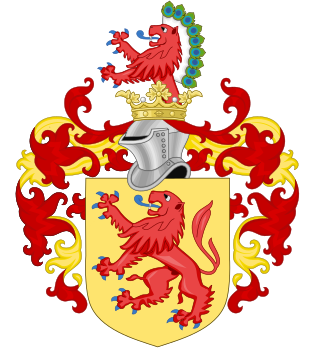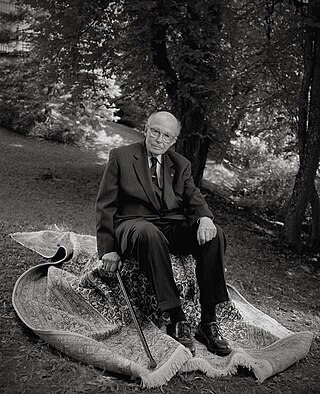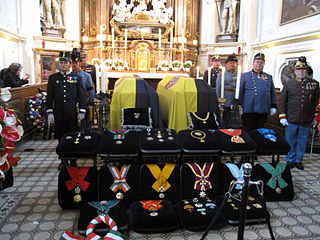
The House of Habsburg, also known as the House of Austria, is one of the most prominent and important dynasties in European history.

The House of Wittelsbach is a former Bavarian dynasty, with branches that have ruled over territories including the Electorate of Bavaria, the Electoral Palatinate, the Electorate of Cologne, Holland, Zeeland, Sweden, Denmark, Norway, Hungary, Bohemia, and Greece. Their ancestral lands of Bavaria and the Palatinate were prince-electorates, and the family had three of its members elected emperors and kings of the Holy Roman Empire. They ruled over the Kingdom of Bavaria which was created in 1805 and continued to exist until 1918.

The House of Babenberg was a noble dynasty of Austrian Dukes and Margraves. Originally from Bamberg in the Duchy of Franconia, the Babenbergs ruled the imperial Margraviate of Austria from its creation in 976 AD until its elevation to a duchy in 1156, and from then until the extinction of the line in 1246, whereafter they were succeeded by the House of Habsburg, to which they were related.

Rudolf I was the first King of Germany from the House of Habsburg. The first of the count-kings of Germany, he reigned from 1273 until his death in 1291.

Otto von Habsburg was the last crown prince of Austria-Hungary from 1916 until the dissolution of the empire in November 1918. In 1922, he became the pretender to the former thrones, head of the House of Habsburg-Lorraine, and sovereign of the Order of the Golden Fleece upon the death of his father. He resigned as Sovereign of the Golden Fleece in 2000 and as head of the Imperial House in 2007.

Joseph I was Holy Roman Emperor and ruler of the Austrian Habsburg monarchy from 1705 until his death in 1711. He was the eldest son of Leopold I, Holy Roman Emperor from his third wife, Eleonor Magdalene of Neuburg. Joseph was crowned King of Hungary at the age of nine in 1687 and was elected King of the Romans at the age of eleven in 1690. He succeeded to the thrones of Bohemia and the Holy Roman Empire when his father died.

The emperor of Austria was the ruler of the Austrian Empire and later the Austro-Hungarian Empire. The hereditary imperial title and office was proclaimed in 1804 by Francis II, Holy Roman Emperor, a member of the House of Habsburg-Lorraine, and continually held by him and his heirs until Charles I relinquished power in 1918.

Archduke was the title born from 1358 by the Habsburg rulers of the Archduchy of Austria, and later by all senior members of that dynasty. It denotes a rank within the former Holy Roman Empire (962–1806), which was below that of Emperor, and roughly equal to King, Prince-Archbishop, and Grand prince, but above that of a Grand Duke, Sovereign Prince, and Duke.

Archduchess Louise of Austria was by marriage Crown Princess of Saxony as the wife of the future King Frederick Augustus III.

Albert II, known as the Wise or the Lame, a member of the House of Habsburg, was duke of Austria and Styria from 1330, as well as duke of Carinthia and margrave of Carniola from 1335 until his death.

The Kingdom of Lombardy–Venetia, commonly called the "Lombardo-Venetian Kingdom", was a constituent land of the Austrian Empire from 1815 to 1866. It was created in 1815 by resolution of the Congress of Vienna in recognition of the Austrian House of Habsburg-Lorraine's rights to the former Duchy of Milan and the former Republic of Venice after the Napoleonic Kingdom of Italy, proclaimed in 1805, had collapsed.

Karl Habsburg is an Austrian politician and the head of the House of Habsburg-Lorraine, the former royal house of the defunct Austro-Hungarian thrones. As a citizen of the Republic of Austria, his legal name is Karl Habsburg-Lothringen.

The Duchy of Austria was a medieval principality of the Holy Roman Empire, established in 1156 by the Privilegium Minus, when the Margraviate of Austria (Ostarrîchi) was detached from Bavaria and elevated to a duchy in its own right. After the ruling dukes of the House of Babenberg became extinct in male line, there was as much as three decades of rivalry on inheritance and rulership, until the German king Rudolf I took over the dominion as the first monarch of the Habsburg dynasty in 1276. Thereafter, Austria became the patrimony and ancestral homeland of the dynasty and the nucleus of the Habsburg monarchy. In 1453, the archducal title of the Austrian rulers, invented by Duke Rudolf IV in the forged Privilegium Maius of 1359, was officially acknowledged by the Habsburg emperor Frederick III.

The Counts of Gorizia, also known as the Meinhardiner, House of Meinhardin, were a comital, princely and ducal dynasty in the Holy Roman Empire. Named after Gorizia Castle in Gorizia, they were originally "advocates" (Vogts) in the Patriarchate of Aquileia who ruled the County of Gorizia (Görz) from the early 12th century until the year 1500. Staunch supporters of the Emperors against the papacy, they reached the height of their power in the aftermath of the battle of Marchfeld between the 1280s and 1310s, when they controlled most of contemporary Slovenia, western and south-western Austria and north-eastern Italy mostly as (princely) Counts of Gorizia and Tyrol, Landgraves of Savinja and Dukes of Carinthia and Carniola. After 1335, they began a steady decline until their territories shrunk back to the original County of Gorizia by the mid 1370s. Their remaining lands were inherited by the Habsburg ruler Maximilian I.

Sommeregg is a medieval castle near Seeboden in the Austrian state of Carinthia, Austria. It is situated in the foothills of the Nock Mountains at an altitude of 749 m.

Archduke Hubert Salvator of Austria, Prince of Tuscany was a member of the Tuscan line of the House of Habsburg and Archduke of Austria, Prince of Tuscany by birth.

Archduke Maximilian of Austria was a member of the House of Habsburg-Lorraine and the younger brother of the Emperor Charles I of Austria.

On 4 July 2011, Otto von Habsburg, also known as Otto of Austria, former head of the House of Habsburg-Lorraine and Sovereign of the Order of the Golden Fleece (1922–2007), and former Crown Prince (1916–1918) and, by pretense, Emperor-King of Austria-Hungary, died at 98 years of age.

The House of Rapperswil respectively Counts of Rapperswil ruled the upper Zürichsee and Seedamm region around Rapperswil and parts of, as of today, Swiss cantons of St. Gallen, Glarus, Zürich and Graubünden when their influence was most extensive around the 1200s until the 1290s. They acted also as Vogt of the most influential Einsiedeln Abbey in the 12th and 13th century, and at least three abbots of Einsiedeln were members of Rapperswil family.
Karoly-Konstantin von Habsburg, is a Hungarian equestrian. He competes in equestrian vaulting. As the son of Georg von Habsburg, he is a member of the House of Habsburg-Lorraine.






















